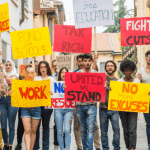 Politics
Politics  Politics
Politics  Weird Stuff
Weird Stuff Ten Bizarre Facts About The Doge Meme
 Our World
Our World 10 Ways Your Christmas Tree Is More Lit Than You Think
 Movies and TV
Movies and TV The 10 Coolest Stars to Set Sail on The Love Boat
 History
History 10 Things You Didn’t Know About the American National Anthem
 Technology
Technology Top 10 Everyday Tech Buzzwords That Hide a Darker Past
 Humans
Humans 10 Everyday Human Behaviors That Are Actually Survival Instincts
 Animals
Animals 10 Animals That Humiliated and Harmed Historical Leaders
 History
History 10 Most Influential Protests in Modern History
 Creepy
Creepy 10 More Representations of Death from Myth, Legend, and Folktale
 Politics
Politics 10 Political Scandals That Sent Crowds Into the Streets
 Weird Stuff
Weird Stuff Ten Bizarre Facts About The Doge Meme
 Our World
Our World 10 Ways Your Christmas Tree Is More Lit Than You Think
Who's Behind Listverse?

Jamie Frater
Head Editor
Jamie founded Listverse due to an insatiable desire to share fascinating, obscure, and bizarre facts. He has been a guest speaker on numerous national radio and television stations and is a five time published author.
More About Us Movies and TV
Movies and TV The 10 Coolest Stars to Set Sail on The Love Boat
 History
History 10 Things You Didn’t Know About the American National Anthem
 Technology
Technology Top 10 Everyday Tech Buzzwords That Hide a Darker Past
 Humans
Humans 10 Everyday Human Behaviors That Are Actually Survival Instincts
 Animals
Animals 10 Animals That Humiliated and Harmed Historical Leaders
 History
History 10 Most Influential Protests in Modern History
 Creepy
Creepy 10 More Representations of Death from Myth, Legend, and Folktale
10 Hitchhiking Pick-Ups That Genuinely Changed History
Hitchhiking is usually seen as a personal journey, an act of fleeting connection between strangers on the open road. Yet, some of history’s most pivotal shifts didn’t begin in grand halls or on battlefields, but with a simple thumb extended by the roadside. These seemingly insignificant moments of chance encounters have, against all odds, subtly steered the course of major historical events. From critical political decisions to life-saving escapes and the very birth of cultural movements, hitchhiking has served as an unlikely conduit for destiny.
This list explores remarkable instances where a spontaneous ride reshaped history in ways no one could have predicted. Prepare to discover how the biggest impacts sometimes begin with the smallest of journeys.
Related: 10 Extremely Simple Concepts That Completely Changed the World
10 Ronald Reagan’s Opportunistic Ride (Launching a Career)
Long before he was president, Ronald Reagan was just another young man trying to get ahead during the Great Depression. Hitchhiking wasn’t a quirky road trip choice back then—it was survival. On one such ride, Reagan thumbed his way to Davenport, Iowa, where the driver dropped him off at a local radio station. That impromptu trip landed him a broadcasting audition at WHO Radio, where he soon became a popular sports announcer.
The radio job snowballed into a Hollywood career and eventually politics, making Reagan one of the most influential figures of the 20th century. Without that chance ride to Davenport, he might never have gotten the break that propelled him onto the national stage. Hitchhiking, in this case, wasn’t just a way to get from one town to another—it was the start of a journey that changed the course of American history.[1]
9 Jack Kerouac’s Formative Journeys (Paving the Way for On the Road)
Jack Kerouac, the iconic Beat Generation author, famously immortalized hitchhiking as a symbol of freedom and rebellion in his seminal novel, On the Road. While the novel is a fictionalized account, it was deeply informed by Kerouac’s own extensive hitchhiking experiences across America in the late 1940s. These unscripted journeys were not merely travel; they were the crucible in which his groundbreaking literary style and philosophical outlook were forged.
Kerouac’s decision to embrace hitchhiking wasn’t just about cheap travel; it was a deliberate act of seeking raw experience, encountering diverse characters, and immersing himself in the vastness of the American landscape. The spontaneous conversations with truckers, farmers, and fellow wanderers, the long stretches of solitude, and the unpredictable nature of the road directly shaped the spontaneous prose style and the existential themes that would define On the Road and, by extension, the Beat Generation.
Without these numerous, formative hitchhiking trips, On the Road would simply not exist in the form that captivated a generation and cemented Kerouac’s legacy. His personal experiences picking up rides and being picked up by strangers provided the authentic raw material for a novel that became a cultural touchstone, inspiring countless others to hit the road and fundamentally altering the landscape of American literature and youth culture.[2]
8 Charles Manson’s California Arrival (The Cult That Followed)
Before he became infamous as a cult leader and mass murderer, Charles Manson arrived in California in the mid-1960s after being released from prison. His journey to the West Coast, specifically to the burgeoning counterculture scene of San Francisco, was facilitated by hitchhiking. This seemingly unremarkable act of seeking rides inadvertently brought a highly manipulative and dangerous individual into a fertile environment for his dark influence to take root.
Manson capitalized on the era’s free-love, communal spirit, quickly drawing a group of disaffected young people, primarily women, into his orbit. His ability to charm, exploit vulnerabilities, and preach a distorted version of counterculture ideals allowed him to establish what became known as the Manson Family. His nomadic, rootless existence, often sustained by moving from one temporary home to another via hitchhiking, allowed him to evade sustained scrutiny while slowly building his cult.
His initial arrival in California by way of hitchhiking put him precisely where he needed to be to gather the followers who would later commit horrific crimes. While hitchhiking itself didn’t create Manson, it served as the literal vehicle that delivered him and his nascent ideology to the unsuspecting West Coast, directly contributing to the eventual formation of the Family and the shocking events that would forever scar American history.[3]
7 The Cross-Country Hippie Movement (The Counterculture Spreads)
Hitchhiking was not just a means of transport; it became a defining symbol and a practical engine for the spread of the American counterculture movement in the 1960s. As young people sought to escape conventional society and explore new communal lifestyles, the thumb became their passport to freedom, allowing ideas, music, and the very spirit of the “hippie” movement to disseminate rapidly across the vast distances of the United States.
Thousands of disillusioned youth embraced hitchhiking as their primary mode of travel, flocking to cultural epicenters like San Francisco’s Haight-Ashbury, the Woodstock festival, or rural communes. This network of free travel created an informal, mobile communication system, allowing counterculture philosophies, anti-war sentiments, drug culture, and rock music to spread organically. Drivers often picked up hitchhikers specifically to hear their stories, exposing a broader segment of society to new ways of thinking.
Without the widespread phenomenon of hitchhiking, the physical spread and cultural impact of the counterculture movement would have been dramatically slower and far less pervasive. It connected individuals from disparate regions, facilitated spontaneous gatherings, and turned the nation’s highways into arteries for a social revolution, profoundly shaping American youth culture, politics, and music for decades to come.[4]
6 Patriotic Hitchhiking in World War II (A National Duty)
During World War II, hitchhiking took on a distinctly patriotic flavor. With gasoline rationing and carpooling encouraged, American motorists were urged to pick up soldiers on the roadside as both a moral duty and a way to support the war effort. Posters and slogans hammered the point home, with one famous line declaring: “When you ride ALONE, you ride with Hitler.”
Giving a serviceman a lift wasn’t just about saving fuel—it became a small but symbolic act of solidarity. Thousands of soldiers got to bases, families, and new assignments thanks to ordinary citizens willing to share their vehicles. Each ride underscored a sense of collective sacrifice and national unity that defined the home front.
This patriotic form of hitchhiking demonstrated how even the simple act of pulling over for a stranger could connect individuals to the broader struggle of World War II. It blurred the line between civilian and soldier, and showed how grassroots acts of kindness and obligation could support a global war effort.[5]
5 Hitchhikers of the Great Depression (A Survival Strategy)
During the Great Depression of the 1930s, hitchhiking became not just a choice, but a matter of survival. With unemployment soaring and families uprooted, millions of Americans took to the road in search of work, food, or simply a fresh start. Cars were scarce and money scarcer, so standing by the roadside with a thumb out became a common sight across the country.
For many, this wasn’t about youthful adventure—it was about reaching the next harvest, the next factory town, or the next sympathetic family willing to offer help. Hitchhiking allowed desperate workers to follow seasonal labor, young men to leave struggling families and look for jobs elsewhere, and countless people to keep moving in the face of despair.
This wave of hitchhiking shaped a generation’s relationship to mobility and survival. It also embedded the image of the hitchhiker into American folklore, inspiring everything from photography and novels to later road narratives. More than just a way to get from one town to another, hitchhiking in the Depression embodied the resilience and restlessness of a country struggling to endure.[6]
4 Steve Jobs’s Spiritual Journey to India (Founding Apple’s Ethos)
Before co-founding Apple and revolutionizing personal computing, Steve Jobs embarked on a transformative spiritual journey to India in 1974. With limited funds, his primary mode of transport through the subcontinent was hitchhiking. These arduous and often unpredictable rides profoundly shaped his worldview, his approach to design, and ultimately, the philosophical underpinnings of one of the world’s most influential companies.
Jobs’s experiences hitchhiking through remote villages and bustling cities exposed him to different ways of thinking, to Eastern spiritual practices, and to a simplicity of life that stood in stark contrast to Western consumerism. The forced encounters with strangers, the reliance on serendipity, and the physical challenges of the journey instilled in him a deeper appreciation for intuition, a focus on user experience, and a desire to create products that were both functional and aesthetically pure.
This formative period, facilitated by his hitchhiking travels, instilled core tenets that would later become hallmarks of Apple’s design philosophy: simplicity, intuitive interfaces, and a desire to create tools that empower individuals. His cross-continental rides were not just a youthful adventure; they were a foundational experience that indirectly contributed to the ethos of a company that would change how the world interacts with technology, illustrating how a personal journey can lead to a global revolution.[7]
3 The Escape of the Prague Spring Dissidents (Fleeing Soviet Repression)
Following the Soviet-led invasion of Czechoslovakia in August 1968, which crushed the “Prague Spring” reforms, many intellectuals, artists, and political reformers found themselves targeted by the new, hardline regime. With borders heavily controlled and official travel restricted, some dissidents made daring escapes, often relying on the kindness of strangers and the clandestine network of sympathetic individuals—including hitchhiking—to reach freedom in the West.
These desperate attempts involved navigating treacherous border crossings, evading Soviet patrols, and finding ways to blend in as they moved across occupied territory. For many, formal transportation was out of the question due to surveillance. Hitchhiking became a dangerous, yet sometimes effective, method of travel, relying on the hope that the person offering a ride would not be an informer, but rather a fellow citizen disgusted by the occupation.
While not a single, publicized event, the collective act of political refugees and dissidents hitchhiking their way to safety represented a quiet form of resistance and had a profound impact on the international perception of Soviet brutality. These perilous journeys, often successful due to the bravery of drivers willing to take the risk, ensured the survival of key voices who could then provide firsthand accounts of the repression, contributing to global awareness and solidarity with the suppressed Czechoslovakian movement.[8]
2 Forrest Gump’s Cross-Country Run (Inspiring a Generation)
While a fictional character, Forrest Gump’s decision to “just feel like runnin’” across America captured the imagination of millions and became a powerful cultural phenomenon. His spontaneous, multi-year journey, which often involved periods of hitchhiking, was not just a personal quest but inadvertently inspired a diverse following and became a symbol of endurance, simplicity, and the pursuit of individual freedom that resonated deeply with audiences.
As Gump ran, he accumulated a bizarre and motley crew of followers who were inspired by his seemingly aimless yet determined journey. While not always directly picking up hitchhikers in the traditional sense, his journey became a magnet for those seeking meaning or escape, embodying the spirit of the open road and the quest for something more. His simple act of running, fueled by the occasional ride or interaction with strangers, transformed into a national spectacle.
The cultural impact of Gump’s journey, which heavily featured him navigating the vast American landscape and interacting with strangers, was immense. It popularized the idea of cross-country endurance feats. It highlighted the diverse tapestry of American life accessible to anyone willing to hit the road. Forrest Gump became a cinematic touchstone, and the character’s hitchhiking and running adventures left a lasting impression on popular culture, encouraging a generation to embrace unexpected journeys and simple acts of profound impact.[9]
1 The Dissemination of Early Punk Rock (The DIY Road Trip)
In the nascent stages of the punk rock movement in the mid-1970s, before major labels took notice, many aspiring bands and their dedicated fans relied heavily on hitchhiking to spread their raw, rebellious sound across cities and even countries. This low-budget, DIY mode of travel was integral to the movement’s ethos, allowing punk’s anti-establishment message and explosive energy to disseminate far beyond established music scenes.
Unlike mainstream artists who could afford tour buses, early punk bands and their followers often had no choice but to hitchhike to gigs, to meet like-minded individuals, or simply to escape their hometowns. This created a grassroots network where ideas, fanzines, demo tapes, and the very spirit of punk were exchanged in car rides, truck cabs, and gas station parking lots. Every ride was a chance to evangelize, recruit, and further the counter-cultural revolution.
Without the widespread reliance on hitchhiking, the organic, rapid spread of early punk rock would have been significantly hampered. It connected isolated scenes, allowed bands to play in far-flung venues, and fostered a sense of community among outsiders. This seemingly informal mode of transport directly fueled punk’s explosive growth, demonstrating how a simple act of shared travel could unintentionally become the engine for a global music and cultural revolution.[10]








